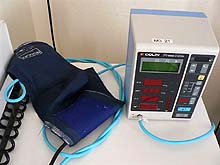What Is Normal Blood Pressure?

Arteries and veins form a closed circuit (filled with blood) fitted with an in line pump, the heart. The heart contracts, forcing blood via the arteries to all parts of the body. Every surge of blood causes a palpable pulsation: the pulse.
Following every contraction, the heart relaxes. During contraction the pressure in the arteries reaches a peak. When measured, this is called the systolic pressure, also known as the upper value or reading. With the heart at rest, the pressure drops; but not to zero. This is called the diastolic or lower reading.
Blood pressure is measured by wrapping a cuff around the upper arm which is inflated until all flow is cut off. During slow deflation of the cuff one listens, by means of a stethoscope, waiting for the pulse to appear and later disappear, noting the readings at both instances. Pressure within the cuff is registered by either a mercury or aneroid baumanometer.
Normal blood pressure is 120/80 or below. While it's true that blood pressure tends to rise with age, that's no reason to feel complacent: such a rise will always carry with it an increased risk of heart attack, stroke, kidney failure, and other complications of high blood pressure (hypertension).
Blood pressure normally varies throughout the day, often by 40 points or more. Exercise and stress are especially likely to increase it, while relaxation and sleep will usually lower it. Standing up or talking, for example, can increase blood pressure by 10 or more points. Even simply worrying about blood pressure will increase it. If your blood pressure is only high when you're exercising or when you're at the doctor's office, that's okay. But if it's high even part of the time in routine situations, that is abnormal and deserves treatment.
|